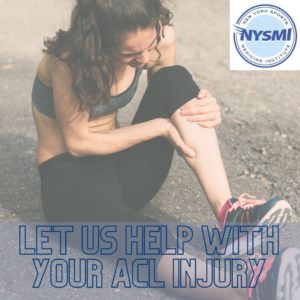
06 Aug Can You Walk With A Torn ACL?
The signs of a torn ACL are easily recognizable. A loud popping sensation or sound in the knee, rapid swelling, severe pain all point to an ACL injury. Unfortunately, this injury is all too common among athletes and is universally dreaded. If you’re dealing with an ACL injury, our team at New York Sports Medicine Institute is here to help. We provide quality orthopedic care to our patients to help them get back on the field and in top playing condition. Please continue reading to learn more about how we address ACL tears.
ACL Tears
The anterior cruciate ligament (ACL) is a fibrous, tough band of connective tissue found in the knee that provides support and stability in the joint. The ACL is one of the four most important ligaments found in the knee and helps facilitate movement. ACL tears most commonly occur during activities that involve abrupt stops or sudden changes in direction or jumping and landing. Athletes that play soccer, football, lacrosse, and basketball are more susceptible to this injury. One of the telltale signs of an ACL tear is an audible popping sensation or sound during the injury and swelling and instability in the knee. Some other signs of an ACL tear can include:
- Swelling.
- Severe pain.
- Limited range of motion.
- Inability to bear weight on the injured leg.
The ACL is the primary stabilizer in the knee, and a torn ACL can lead to feelings of instability when walking or changing directions. After your injury, you may be able to walk in a straight line, but changing directions can be a challenge. Even if you can still walk after an injury, this does not rule out an ACL tear. Walking with a torn ACL can exacerbate your injury and cause additional damage to the joint. Our dedicated staff will evaluate your situation and determine the best course of action to eliminate your pain and facilitate your recovery.
How To Treat ACL Tears
Seeking the help of our team at New York Sports Medicine Institute for your ACL tear can help ensure you make a speedy recovery. One of the first courses of treatment we may recommend after an injury is resting. Our team may also recommend that you use crutches or a knee brace to limit weight-bearing on the injured leg. Depending on the severity of the tear, more conservative treatments are recommended at first. If your ACL tear is more severe, you may require surgery to repair the tendon. Surgical repair of an ACL tear typically involves reconstruction of the ligament using a tendon graft. This reconstruction surgery can be performed arthroscopically. After surgery, physical therapy may be necessary to ensure an optimal recovery.
Preventing ACL Injuries
An ACL tear is a universally dreaded injury, but it can be prevented. Being aware of the certain risk factors and behaviors associated with ACL tears can help you stay vigilant and prevent ACL tears from sidelining you in the future. Here are some of the ways you can ensure a safe sports season and maintain a healthy ACL:
- Implement strength training.
- Warm up and stretch before activity.
- Focus on your balance.
- Strengthen the muscles of your feet, legs, and ankles.
- Wear proper footwear.
- Practice proper athletic technique.
Contact Us
Despite our best efforts, ACL tears happen, which is why our team at New York Sports Medicine Institute is here to help! We offer some of the most effective treatment options for ACL injuries. From orthopedic surgery to physical therapy, our experienced staff is well-versed in helping athletes return to play after an ACL injury. To learn more about how we manage ACL tears or to schedule an appointment, be sure to contact our team today!


